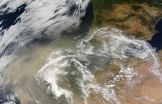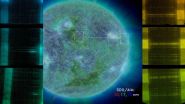(Press-News.org) Spanish and Portuguese researchers have analysed the composition and radiative effect of desert aerosols during two episodes which simultaneously affected Badajoz (Spain) and Évora (Portugal) in August 2012. Results show that the intrusion of dust from the Sahara Desert caused radiative cooling of the Earth's surface.
Atmospheric aerosols (solid or liquid particles suspended in the atmosphere) are difficult to examine for various reasons. Firstly, they remain in the atmosphere for a short time and secondly, their cause may be natural or anthropogenic.
Yet there is no doubt that research into atmospheric aerosols is becoming increasingly important due to the effects that they can have on the global temperature of the Earth, given that solar radiation is the main source of energy for the Earth-Atmosphere system. Aerosols also affect human health, ecosystems and the water cycle.
For this reason, a group of researchers from Extremadura (Spain) and Portugal has analysed the radiative effect of a type of natural aerosol (the dust from the desert areas), of great interest to the Iberian Peninsula due to the proximity of the Sahara desert.
The scientists focused their study, published in the journal 'Atmospheric Research', on two desert aerosol intrusions which occurred in August 2013 and that affected two monitoring stations in the south-west of the Iberian Peninsula, in Évora and Badajoz, which belong to the AErosol RObotic NETwork (AERONET) and are managed by NASA.
During these two significant events, "the amount of radiation that reached the surface was less than that which would done if these aerosols had not been there," Mª Ángeles Obregón, researcher in the Physics department of the University of Extremadura (UEx) and the University of Évora (Portugal) and lead author of this study, explains to SINC.
Presence of pollution causes greater impact
By studying the precise measurements of these intrusions, the team determined that although the second desert dust intrusion was more intense (with a greater concentration of PM10 particles), it was in fact the earlier one which caused a greater degree of radiative cooling in both places. As the study underlines, this is due to the presence of absorbent aerosols from anthropogenic pollution.
"It was not only a mix of desert aerosol and pollution but there were also surface and column measurements. This is not always possible, given that the measurements are often contaminated by cloud cover and are fragmented, or simply do not exist because the instruments are calibrating themselves," the researcher clarifies.
During this event, the aerosols stayed close to the surface due to the presence of a anticyclone hovering over the study region at sea-level, "reducing the amount of shortwave irradiance reaching the surface and causing greater radiative cooling," states Obregón, who likens the effects of desert dust with those resulting from certain forest fires or episodes of high pollution.
However, the expert indicates that it is important to bear in mind that the effects of each type of aerosol are different due to their "varying composition, size and properties," she concludes.
INFORMATION:
Reference:
Obregón, M.A et al. "Aerosol radiative effects during two desert dust events in August 2012 over the Southwestern Iberian Peninsula" Atmospheric Research 153(404-415) DOI: 10.1016/j.atmosres.2014.10.007 February 2015
INFORMATION:
(PHILADELPHIA) - Multiple sclerosis (MS) is caused by immune cells that activate a cascade of chemicals in the brain, attacking and degrading the insulation that keeps neuronal signals moving. These chemicals, called cytokines, drive the inflammation in the brain, attracting more immune cells, and causing the debilitating disease marked by loss of neurological function. Researchers have long debated which cytokines drive the disease and which are merely accessory. Now, a study published online April 27th, in the Journal of Immunology, confirms that the cytokine GM-CSF ...
29.04.2015: In these days, it was again tragically demonstrated that the Himalayas are one of the most active geodynamic regions of the world. Landslides belong to the most important geohazards. Besides earthquakes they are triggered mainly by strong rainfall events. A team of scientists from Nepal, Switzerland and Germany was now able to show how erosion processes caused by the monsoon are mirrored in the sediment load of a river crossing the Himalaya.
The geoscientists used data from two stations along the Kali Gandaki, a river that traverses the Himalaya from North ...
Most people are naturally adept at reading facial expressions -- from smiling and frowning to brow-furrowing and eye-rolling -- to tell what others are feeling. Now scientists have developed ultra-sensitive, wearable sensors that can do the same thing. Their technology, reported in the journal ACS Nano, could help robot developers make their machines more human.
Nae-Eung Lee and colleagues note that one way to make interactions between people and robots more intuitive would be to endow machines with the ability to read their users' emotions and respond with a computer ...
Today the national science academies of the G7 countries handed three statements to their respective heads of government for discussion during the G7 summit at Schloss Elmau in early June 2015. The papers on antibiotic resistance, neglected and poverty-related diseases, and the future of the ocean were drawn up by the seven national academies under the aegis of the German National Academy of Sciences Leopoldina.
The G7 academies call for a comprehensive strategy to tackle health threats from infectious diseases; progress toward preventing, controlling and eliminating ...
Computer science researchers have turned to unlikely sources - including Enron - for assembling huge collections of spreadsheets that can be used to study how people use this software. The goal is for the data to facilitate research to make spreadsheets more useful.
"We study spreadsheets because spreadsheet software is used to track everything from corporate earnings to employee benefits, and even simple errors can cost organizations millions of dollars," says Emerson Murphy-Hill, an assistant professor of computer science at NC State and co-author of two new papers ...
NEW YORK (April 29, 2015) - A new study found one in five nursing home residents with advanced dementia harbor strains of drug-resistant bacteria and more than 10 percent of the drug-resistant bacteria are resistant to four or more antibiotic classes. The research was published online today in Infection Control & Hospital Epidemiology, the journal of the Society for Healthcare Epidemiology of America.
"Nursing home residents with advanced dementia usually have an increased need for healthcare worker assistance, as well as frequent exposure to antibiotics. This combination ...
An update search enlarged the pool of study data, but did not change the content of the conclusion of the benefit assessment of stem cell transplantation (SCT) for multiple myeloma conducted in 2012. Overall, the evidence base remained insufficient: Until now, data on quality of life have not been recorded in any study at all. And three large studies, some of which were under German management, have not been completely published even more than 10 years after their completion. This is the conclusion of a rapid report published by the Institute for Quality and Efficiency ...
When consumer budgets grow or shrink, how do spending habits change? A common view is that people with a budget will spend their money on the same number of products, even when their previous budget was lower or higher. But in order to keep their favorite items, consumers whose budgets have shrunk to a particular amount will opt for less variety than someone whose budget has increased to that same amount, according to a new study in the Journal of Marketing Research. Investors beware!
"We call this the budget contraction effect," write authors Kurt A. Carlson (Georgetown ...
(NEWARK, NJ) - April 29, 2014 - A woman is brutally assaulted, but rather than receiving the sympathy she deserves, she is blamed. If she had dressed differently or acted differently, or made wiser choices, others say, she would have been spared her ordeal. For victims, this "victim blaming" is profoundly hurtful, and can lead to secondary victimization.
Psychologists have long realized that blaming victims is a defense mechanism that helps blamers feel better about the world, and see it as fair and just. But ways to prevent victim blaming have been elusive -- until ...
The sun's surface is blisteringly hot at 10,340 degrees Fahrenheit -- but its atmosphere is another 300 times hotter. This has led to an enduring mystery for those who study the sun: What heats the atmosphere to such extreme temperatures? Normally when you move away from a hot source the environment gets cooler, but some mechanism is clearly at work in the solar atmosphere, the corona, to bring the temperatures up so high.
Clear evidence now suggests that the heating mechanism depends on regular, but intermittent explosive bursts of heat, rather than on continuous gradual ...

